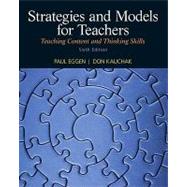
Note: Supplemental materials are not guaranteed with Rental or Used book purchases.
Purchase Benefits
What is included with this book?
PAUL EGGEN
Paul has worked in higher education for thirty-eight years. He is a consultant for public schools and colleges in his university service area and has provided support to teachers in twelve different states. Paul has also worked with teachers in international schools in twenty-three countries, including Africa, South Asia, the Middle East, Central America, South America, and Europe. He has published several articles in national journals, is the co-author or co-editor of six other books, and presents regularly at national and international
conferences.
Paul is strongly committed to public education. His wife is a middle school teacher in a public school, and his two children are graduates of public schools and state universities.
DON KAUCHAK
Don has taught and worked in schools and in higher education in nine different states for thirty-five years. He has published in a number of scholarly journals, including the Journal of Educational Research, Journal of Teacher Education, Teaching and Teacher Education, Phi Delta Kappan, and Educational Leadership. In addition to this text, he has co-authored or co-edited six other books on education. He has also been a principal investigator on federal and state grants examining teacher development and evaluation practices, and he presents regularly at the American Educational Research Association. He currently volunteer-tutors first-, second-, and third-graders in a local elementary school.
Don strongly believes in the contribution that public schools make to our democracy, and his two children benefited greatly from their experiences in state-supported K–12
schools and public institutions of higher education.
Chapter 1: Models of Teaching and Developing as a Teacher
Teachers make a difference
The need for instructional alternatives
Learning and teaching in today’s world
Decision making and reflective practice
Chapter 2: Learning, Motivation, and Models of Teaching
The importance of classroom climate
Cognitive learning theory
Learner motivation
Chapter 3: Essential Teaching Strategies and the Teaching of Thinking
Planning for instruction: An essential teaching strategy
Learning activities: Implementing essential teaching strategies
Essential teaching strategies and the teaching of thinking
Chapter 4: Student-Student Interaction Strategies: Groupwork, Cooperative Learning, and Discussions
Features of effective groupwork and cooperative learning
Groupwork strategies
Cooperative learning strategies
Discussion strategies
Cooperative learning and discussions in different learning environments
Chapter 5: The Guided Discovery Model
Content taught with the Guided Discovery Model
Planning lessons with the Guided Discovery Model
Implementing lessons using the Guided Discovery Model
Adapting the Guided Discovery model in different learning environments
Assessing student learning
Chapter 6: The Concept Attainment Model
Learning objectives for the Concept Attainment Model
Planning lessons with the Concept Attainment Model
Implementing lessons using the Concept Attainment Model
Adapting the Concept Attainment Model in different learning environments
Assessing student learning in Concept Attainment activities
Chapter 7: The Integrative Model
Learning goals for the Integrative Model
Planning lessons with the Integrative Model
Implementing lessons using the Integrative Model
Adapting the Integrative Model in different learning environments
Assessing student learning when the Integrative Model is used
Chapter 8: Problem-based Learning
Planning Problem-based Learning lessons
Implementing Problem-based Learning lessons
Inquiry
Adapting problem-based instruction in different learning environments
Assessing learning in problem-based activities
Chapter 9: The Direct Instruction Model
Planning lessons with the Direct Instruction Model
Implementing lessons using the Direct Instruction Model
Adapting the Direct Instruction Model in Different Learning Environments
Assessing student understanding when using the Direct Instruction Model
Chapter 10: The Lecture-Discussion Model
Lectures and lecture-discussions
Planning lessons using the Lecture-Discussion Model
Implementing Lecture-Discussion Model
Adapting the Lecture-Discussion Model in different learning contexts
Assessing learning when using the Lecture-Discussion Model
Glossary
References
Index
The New copy of this book will include any supplemental materials advertised. Please check the title of the book to determine if it should include any access cards, study guides, lab manuals, CDs, etc.
The Used, Rental and eBook copies of this book are not guaranteed to include any supplemental materials. Typically, only the book itself is included. This is true even if the title states it includes any access cards, study guides, lab manuals, CDs, etc.